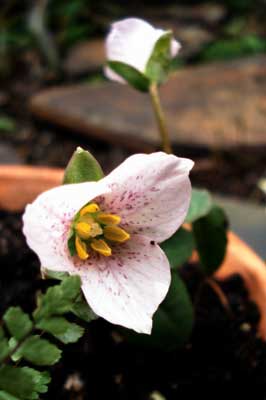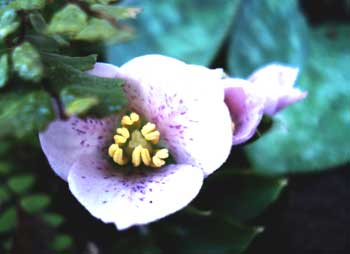
Siskayou Wakerobbin
aka, Stream Trillium
or, Brook Trillium
Where are the sweet, old-fashioned posies,
Quaint in form and bright in hue,
Such as grandma gave her lovers
When she walked the garden through?
-from Old-Fashioned Flowers
Ethel Lynn Beers
Native to to the northwest corner of California & southwest corner Oregon, Pseudotrillium rivale (formerly Trillium rivale & still too commonly listed as such) is a small, pink-flowering spring ephemeral known variously as Brook Trillium, Stream Trillium, or the Siskayou Wakerobbin. It is the only species in the new genus, but for its general care & behavior, it's still a trillium.Ethel Lynn Beers
This rarity is restricted to the Klamath & Siskiyou Mountains, found on high banks overlooking streams, wet edges of Darlingtonia californica Cobra Lily bogs, but also in relatively dry soils in the shade of manzanita bushes or open grasslands & under sequoias or pines.
 Its soil choices in the wild tend to be low in potassium but rich in magnesium & iron. In the garden, it prefers partial shade or bright shade at the edge of a woodland garden, moist well-draining soil which can be drier autumn & winter.
Its soil choices in the wild tend to be low in potassium but rich in magnesium & iron. In the garden, it prefers partial shade or bright shade at the edge of a woodland garden, moist well-draining soil which can be drier autumn & winter. As with other trilliums, first year seedlings show only one leaf. But instead of the strap-leaf of true trilliums, the first-year leaf of the Pseudotrillium resembles a diminutive arum leaf.
This first showing is not a true leaf, but a cotyledon or embryonic leaf. The second year it may again show only one cotyledon, but may have developed enough to produce two fingernail-sized true leaves. The third or fourth year it'll have the requisite three leaves, shiny & heart-shaped with clearly marked veins; it finally looks like a trillium. It can take three more years before it is mature enough to bloom.
It can grow to six inches height but ours is still such a youngster. It slightly nodding blooms gave it only two inches of height! When the bloom fades, the leaves have a burst of growth & may last through most of summer, or may go dormant early or mid summer, depending it seems on whether or not temperatures get to high or moisture drops.
I had not expected this small trillium to be quite so small, & made the mistake of planting it with a dwarf fern which simply overwhelmed it. I was not able to get good photos of it the first year it bloomed because it was so hidden by the little (but comparatively big) fern & the leaves of a dogtooth lily at the opposite end of the medium-sized pot. When it was beginning to fade away I dug it up & planted it in its own pot, with a super-tiny groundcover to fill out the pot a bit.
This trillium's April & May flower petals are rather stubby, & somewhat cupped, for a three-point star-cup big around as a nickel. The blooms are white with a striking purple speckling within. There is also a pink form; the white does not age to pink as do such natives as Trillium ovatum, so the pink ones are a distinct strain.
The pot we keep in partial shade on a decorative wire rack with other small things underneath the eaves by the porch steps, so that in winter it will be pretty much dry, & gets most of its watering by hand. In the open garden the risk of excess moisture during winter wouldn't be great, but pots just can't drain rapidly enough during our persistent winter rains.
With luck our two small plants will spread a little bit each year, upon horizontal rhizomes, until the pot has a substantial mat of tiny flowers. At that point we will consider whether or not to transfer it to the hepatica garden, or to continue to keep it as a potted gem. As a young plant it's not apt to survive amidst the hepatica but a substantial patch would probably do fine in such company.